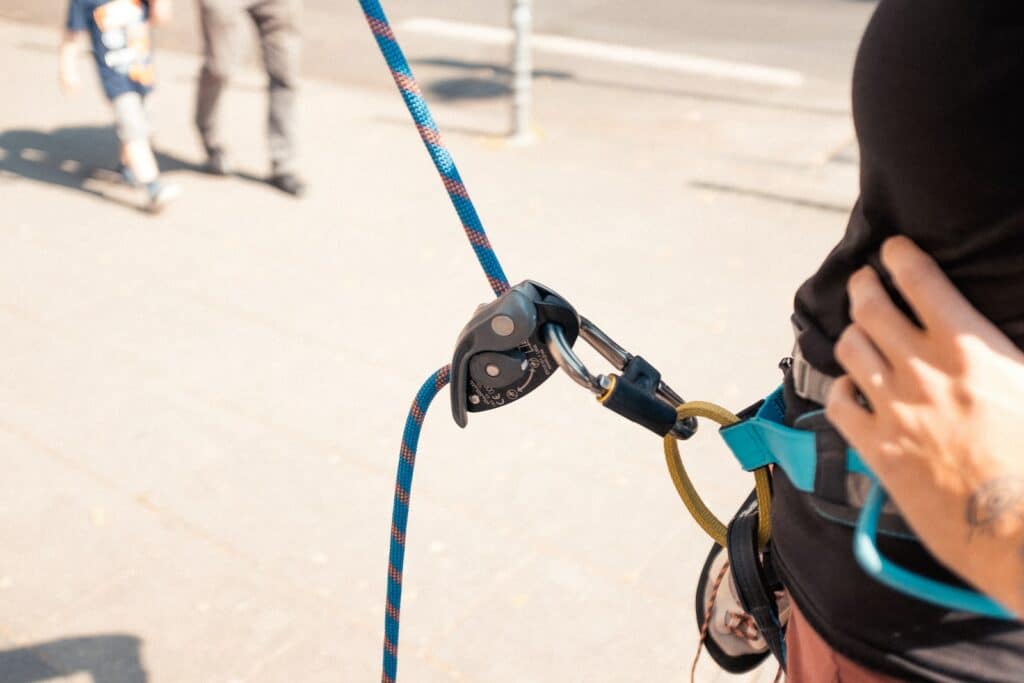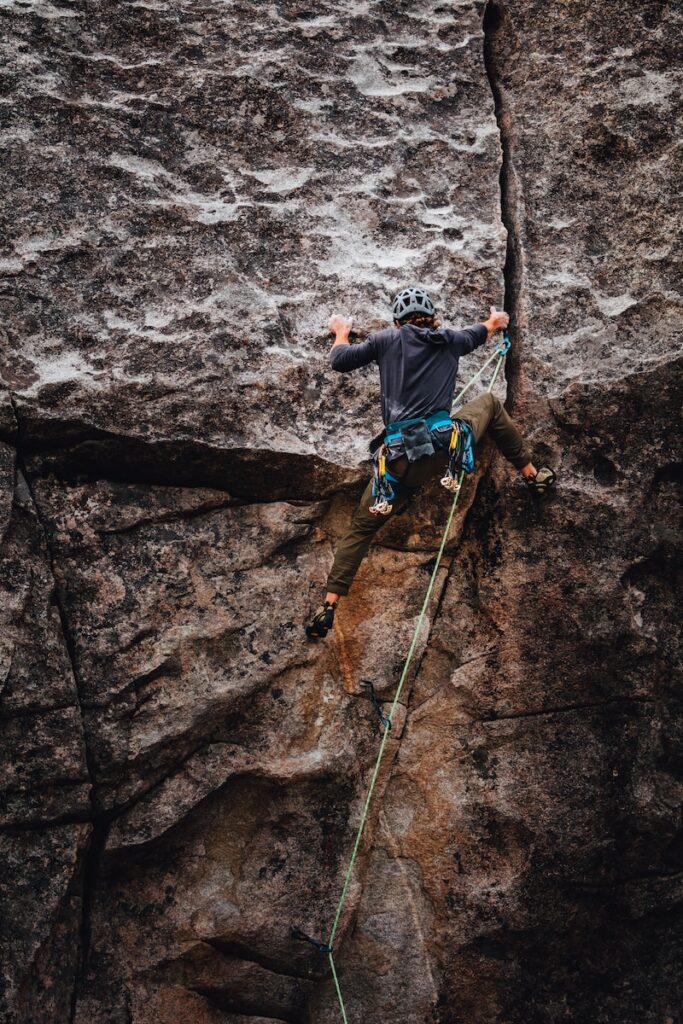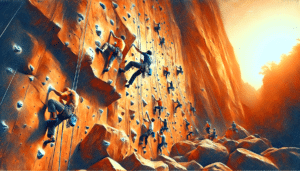Rock climbing is a thrilling and challenging sport that involves ascending vertical or near-vertical walls using ropes and specialized equipment. There are several types of roped climbing, with lead climbing and rock climbing top rope being the most common. In this article, we will explore these two types of climbing and discuss why you might choose one over the other.
Table of Contents
ToggleWhat is rock climbing top rope?
Rock Climbing Top rope is a popular form of roped climbing that is commonly found in commercial climbing gyms. In top rope climbing, the rope is secured to the top of the climb or wall, hence the name “top rope.” The anchors for the rope are usually permanent and fixed, providing a secure attachment for the climber. When Rock Climbing Top Rope, you are always protected by the rope and the belayer, who manages the rope from the ground.
Most climbing gyms have designated rock climbing top rope walls with double-wrap ropes around the anchor. This setup allows for a three/four to one climber-to-belayer weight ratio. It means that even a belayer who weighs much less than the climber can safely manage the rope. However, this also makes belaying on a double-wrapped top rope more physically demanding due to the increased friction in the system.
When climbing outdoors, an experienced climber will establish an anchor using available secure fixed points such as trees, rocks, or metal bolts drilled into the rock. Outdoor top rope anchors are typically single-wrapped, which reduces the climber-to-belayer weight ratio and results in lower friction.
What is Top Rope Belaying?
Rock Climbing top rope belaying is the act of managing the rope for a climber who is ascending a top rope. The belayer stands on the ground and takes up the excess slack in the rope as the climber ascends. If the climber falls, they are caught immediately by the top rope belayer. The anchor for the top rope is at the top of the wall, allowing the belayer to control the rope’s tension and provide a secure belay for the climber.
What is Lead Climbing?
Lead climbing, also known as sport climbing or traditional climbing, is another common form of roped climbing. In lead climbing, the climber starts with the rope attached only to themselves and their belayer. The climber’s task is to secure the rope at fixed points along the wall as they ascend. Unlike top rope climbing, where there is a single anchor point at the top, lead climbers have multiple fixed anchors along their route.
The fixed anchors in lead climbing consist of bolts, which are stainless steel anchors drilled into the rock and set with strong glue. Additionally, quickdraws are used in lead climbing. Quickdraws are thick webbings with carabiners attached to each end. They are either permanently fixed to the wall or brought to the climb by the climber. The climber attaches the rope to one end of the quickdraw, while the other end is attached to the bolt.
Unlike top rope climbing, where the anchor is fixed at the top, lead climbers must attach their own rope to each subsequent quickdraw as they progress up the wall. In climbing gyms, the quickdraws are already attached to the wall using a quick link, a more durable carabiner. However, when climbing outdoors, the anchor types may vary, and climbers need to be familiar with different anchor setups.
It’s important to note that there is another type of climbing called trad climbing, which falls under the umbrella of lead climbing. Trad climbing, short for traditional climbing, involves placing removable protection devices, such as cams and nuts, into cracks and other features of the rock. Trade climbing requires extensive knowledge and experience and is typically performed outdoors.
What is Lead Belaying?
Lead belaying is the act of managing the rope for a lead climber. Unlike top rope belaying, where the belayer’s role is to take up the excess slack in the rope, lead belaying involves managing the rope’s movement as the climber ascends. The belayer needs to slide the rope through the belay device to allow the climber to advance or take in slack when necessary.
Since the rope moves up the wall with the climber in lead climbing, there is less friction between the belayer and the climber compared to top rope climbing. This means that the belayer needs to be attentive and capable of managing the rope effectively, especially if there is a significant weight difference between the climber and the belayer. When a climber falls on lead belay, they can fall up to twice the distance between them and the last place they clipped into, resulting in potentially large falls.
Lead belaying requires strong communication and attention between the climber and the belayer. The climber needs to be aware of their comfort zone and avoid putting themselves in risky positions, especially when tired. The belayer, on the other hand, must ensure clear communication with the climber and know how to manage the rope and its position relative to the wall and the first anchor. Belaying a lead climber requires a higher level of skill and experience compared to top rope belaying.
The Difference Between rock climbing Lead and Rock climbing top rope
There are many differences when speaking on the topic of lead climbing and top rope climbing. While top rope climbing is accessible to climbers of all skill levels, lead climbing is more technically demanding and mentally challenging. Lead climbing requires climbers to secure the rope at fixed points along the route, adding an extra level of complexity to the climbing experience. Lead belaying, in particular, is considered more challenging than top rope belaying due to the increased risk of falls and the need for precise rope management.
If you are an experienced in Rock Climbing Top Rope, it is not recommended to jump straight into lead climbing without proper training and experience. Lead climbing requires a solid understanding of climbing techniques, anchor systems, and risk management. It is essential to observe and learn from experienced climbers at the gym, ask questions, and seek guidance from climbing professionals. Taking a lead climbing class offered by your local climbing gym can provide hands-on experience and step-by-step instruction for beginners.
Conclusion

In conclusion, rock climbing lead climbing and rock climbing top rope are the two most common types of roped climbing. While top rope climbing is more accessible and suitable for climbers of all levels, lead climbing offers a more challenging and dynamic experience. Both types of climbing require proper training, knowledge, and attention to safety. Whether you choose to top rope or lead climb, always prioritize safety and enjoy the adventure of rock climbing.
We hope you found this article informative and helpful in understanding the differences between lead climbing and top rope climbing. If you have any questions or concerns, feel free to leave a comment below. Happy climbing!












